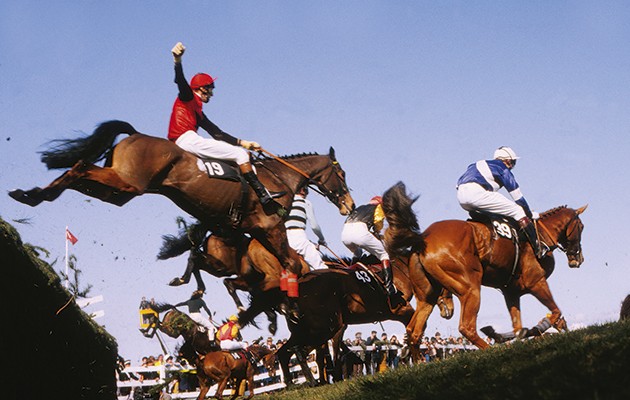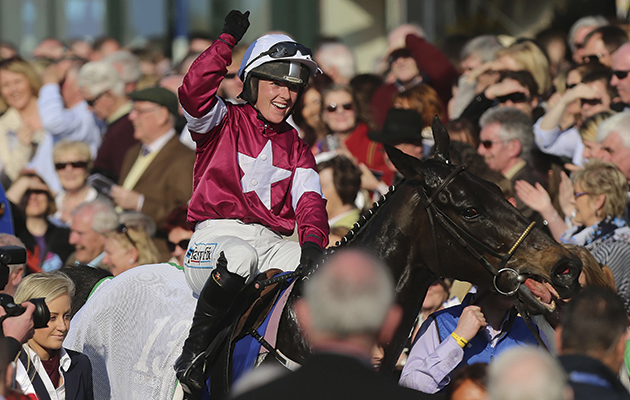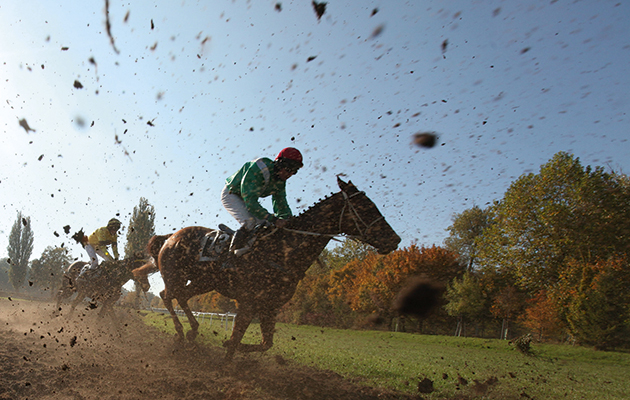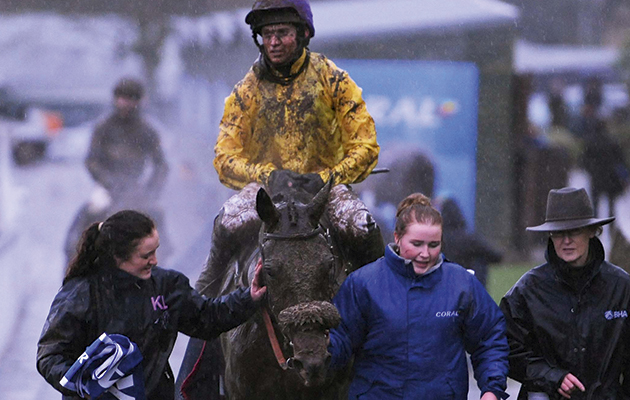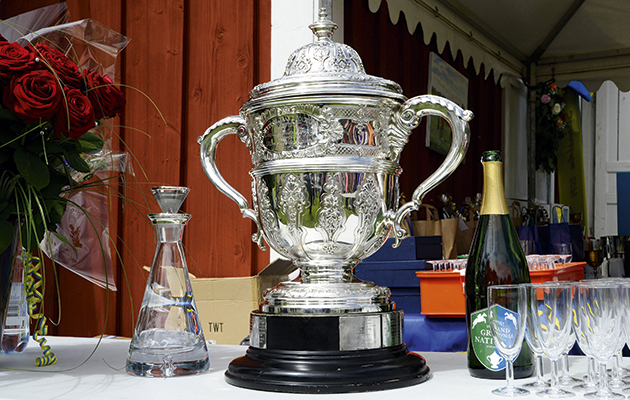First Aintree, then the rest. Other countries were quick to adopt their own Grand Nationals by adapting England’s great steeplechase, says Marcus Armytage
Grand Nationals have swept across the nations since the first at Aintree in 1839. The Grand National at Aintree is the oldest and most challenging steeplechase in the world, run over nearly four and a half miles. Every jump-racing nation has their own Grand Nationals. Here, is a rundown of the 10 biggest and best jump races in the world. Under starters orders… (Read: Red Rum, Aintree’s finest.)
GRAND NATIONALS: GRAND NATIONAL (1839)
The Grand National is the world’s greatest steeplechase; to the horseman it is still the most challenging, to the spectator it remains the most exciting, colourful and dramatic of sporting events and since its inception every jump racing nation has followed suit with their own Grand Nationals.
The irony is the National itself was a copy, of the four-mile Great St Albans Steeplechase. When it was first run in 1839 it was merely a sideshow devised by William Lynn, landlord of Liverpool’s Waterloo Hotel, to keep his punters entertained on a day off during the then much bigger event, greyhound coursing’s Waterloo Cup, which Lynn, a man of huge sporting foresight, had also created.
It has spawned phrases in the English language, such as “to do a Devon Loch” , which is to slip up when in a winning position in sight of the winning post – and sporting calamities are likened to “a Foinavon” after the 1967 race that saw the rank outsider take the plate as most of the field were hampered or fell.
Its most famous fence is named after Capt Martin Becher, the leading rider of the day. During the first running he took a ducking in the brook that now bears his name. When Becher, whose support gave Lynn’s venture some much-needed impetus, emerged he reputedly remarked that “water should never be taken without brandy”.
GRAND NATIONALS: SCOTTISH NATIONAL (1858)
Scotland’s premier chase is run over four miles and 27 birch fences at Ayr in April, generally a fortnight after Aintree, and is occasionally a consolation for Grand National fallers or a guide for the following season’s National.
Begun in 1858 at Houston, Renfrewshire and predominantly run over stone walls, it moved to Bogside in 1880 when the leader of the local Free Church complained. In 1965 it moved to Ayr. Several horses have won Scottish and Grand Nationals including Earth Summit who is the only horse to have won the Scottish, Welsh and Aintree versions.
Because of the proximity time-wise to Aintree it is a big ask these days to win both in the same season. Auroras Encore, the last to try it, was entered because he was owned by a pair of Scots. But the only horse to have done it successfully was the immortal Red Rum in 1974.
GRAND NATIONALS: GRAND-STEEPLECHASE DES FLANDRES (1860)
Always run at Waregem. It did not take long to become famous principally because of the massive water jump in front of the stands called the Gaverbeek.
In 1861 three du Roy de Bliquy brothers rode in the race and were beside each other when they fell in unison at the brook. The course’s own Red Rum was Redpath, who won it an amazing seven times. His last win came in 1897 at the age of 21.
Like all challenging courses, Waregem faced pressure from animal welfare groups to modify parts of the course including the “river”. Its future looks secure, however. A new grandstand has just been built. As Waregem was close to the line on the Western Front (the town has an American cemetery and memorial) the new stand will contain a First World War museum.
GRAND NATIONALS: IRISH NATIONAL (1870)
A three mile, five furlong handicap chase run at Fairyhouse on Easter Monday, often in the same week as its Aintree counterpart.
Five horses have won both the Irish and Grand Nationals: Ascetic’s Silver (1904 and 1906), Rhyme ’N’ Reason (1985, 1988), Bobbyjo (1998, 1999) , Numbersixvalverde (2005, 2006) and I Am Maximus (2023, 2024). Two of its greatest winners, however, Arkle and Desert Orchid never ran at Aintree.
It has been won four times by female jockeys beginning with Ann Ferris on Bentom Boy in 1984. Nina Carberry won it in 2011 on Organisedconfusion while Katie Walsh won it in 2015 on Thunder And Roses. Ruby Walsh won on Burrows Saint in 2019.
The only horse to win it three times was Brown Lad trained by Tom Dreaper. He won it in 1975, 76 and 78.
From 1930 until 1987 it was part of the Irish Hospitals’ Sweepstake. Tickets were sold for £1 in Ireland and North America. If you drew the winning horse you won £50,000 (£1.5 million in today’s money). Sales peaked at £18 million in 1961.
GRAND NATIONALS: GRAND STEEPLE-CHASE DE PARIS (1874)
The Grand Steeple-Chase was inaugurated as the Grand National de Auteuil, a race of three and three-quarter miles over big obstacles.
The most famous fence is the Rivière des Tribunes, the water in front of the stands, which boasts an eight-metre spread. In 1930 British jockey Fred Rees was roundly booed by the big Paris crowd when his horse fell there. There was not much he could do by way of returning the compliment other than flicking a “V” which he considered unoriginal, so he undid his breeches and peed in the water.
Only Jerry M and Troytown have won the Grand-Steeple and the National. Jerry M was second at Aintree in 1910 carrying 12st 7lb, conceding 30lb to the winner, and three months later won in Paris, then the world’s richest steeplechase. In 1912 he returned to win the National at his second attempt when ridden by Ernie Piggott, Lester’s grandfather.
Troytown added the 1920 National to the Grand Steeple he had won in 1919. He went back for another go at the Grand Steeple in which he finished third.
It is generally acknowledged that the last foreign winner of the Grand-steeple, Mandarin trained by Fulke Walwyn, in 1962 involved one of the greatest race-riding feats of all time. The bit in Mandarin’s mouth broke early on and, without brakes or steering, only a combination of leg power and willpower enabled Fred Winter to keep him on the figure-of-eight course. He won a by a head.
GRAND NATIONALS: VELKÁ PARDUBICkÁ (1874)
This race was instigated by cavalry soldiers on the outskirts of the Czech town of Pardubice, now best known for the industrial production of the explosive Semtex. It is run on the second Sunday each October.
Run over four and a quarter miles over turf and plough at a much slower pace than the Grand National, it is more like a cross-country chase than a British chase. However it boasts some of the most fearsome fences outside of Aintree, including wide-open waters, a variety of hedges, an Irish bank, a wall, drops and rails. Until it was partially filled in, if you took width, height and depth of ditch into account, the Taxis could boast of being the biggest fence raced over in the world.
When Czechoslovakia was behind the Iron Curtain, it was very inaccessible to western European runners but that did not stop Chris Collins famously winning it on Stephen’s Society in 1973. Red tape and getting there was as big a barrier as the Taxis. Collins never got his prize-money out if the country but he remains a hero there.
I had three rides in it, finishing sixth in 1990, falling halfway in 1991 and bringing down the Czech equivalent of Red Rum, Zeleznik, who was remounted by jockey Josef Vana before catching up and going on to win a fourth Velká. The British trainer Charlie Mann won it on It’s A Snip in 1995.
In the communist era Russian jockeys could jump the lengthy queue for a car as a reward for completing the course – so tied the reins to their wrists. In the likely event of a fall it meant they would not lose their horse.
GRAND NATIONALS: MARYLAND HUNT CUP (1894)
There are several key differences between The Maryland Hunt Cup, now held on the last Saturday in April, and the National, the main one being the obstacles; it is run over 22 formidable upright timber rails. It is restricted to amateur riders but nevertheless remains the most prestigious steeplechase in America.
It was first run as an inter-hunt contest between the Elkridge and Green Spring, to establish the relative merits of each hunt’s horses. Within a year it was opened up to members of any hunt in Maryland, then America. Timber racing is unique to America and at a solid 4ft 10in the 16th fence is the biggest on the course at Worthington Valley.
Remarkably, Maryland Hunt Cup winners have a 50% strike rate in the Grand National. Jay Trump and Ben Nevis both won at Aintree with American amateur jockeys Tommy Smith and Charlie Fenwick respectively.
GRAND NATIONALS: WELSH NATIONAL (1895)
It has been run at Chepstow since 1949 when Dick Francis rode the winner, Fighting Line. The three mile, five furlong handicap chase over 22 regulation obstacles is traditionally staged the day after Boxing Day on heavy ground.
It is still regarded as a good trial for both the Grand National and Gold Cup. Burrough Hill Lad, Master Oats, Cool Ground and Synchronised are winners that all went on to win Gold Cups. Aintree winners who have doubled up with the Welsh include Rag Trade, Earth Summit, Bindaree and Silver Birch.
One of the most romantic winners was Dream Alliance, owned by members of a working men’s club in Blackwood, Caerphilly, bred there by Janet Vokes on an old slag heap and reared on an allotment. He won the 2009 race and the story was made into a documentary film Dark Horse.
GRAND NATIONALS: NORWEGIAN GRAND NATIONAL (1968)
The Norwegian Grand National was first run in 1968 at Ovrevoll. It was won by Sorrento, a one-time runner-up in the Swedish Derby, ridden by the late Terry Biddlecombe. It was last run in 2002.
The 1999 Norwegian National was won by Trinitro, ridden by Robert Bellamy. The race’s main connection with Aintree came the following year, when Trinitro lined up to try for the double. Sent off at 100-1 he was in front and still going well when he head-butted the first fence.
GRAND NATIONALS: SWEDISH NATIONAL (1971)
A latecomer on the Grand National scene and, at two and three-quarter miles, one of the shortest versions.
In 1970 the organising committee at Stromholm, a twisty-turny racecourse tucked away on the edge of a forest west of Stockholm, were looking to stage a special race to enhance their June meeting.
They wrote to Mirabel Topham, owner of Aintree, asking for her permission to call it the Swedish or Svenskt Grand National. She replied “yes”, said that no one else had ever bothered to ask and promised to send a trophy.
The trophy, weighing 7.2kg (bigger than the FA Cup) and with an engraving of Captain Becher getting a ducking in the first Aintree National, duly arrived in time for Paul Cook, who had just won the Aintree race on Specify, to win the first running on Officer Kelly.
This article was first published in 2016 and has been revised.





